Writing great updates part 2: Designing product narratives
How to design ongoing narratives that turn product updates into compelling stories.

You can ship a feature. You can post about the innovation and value across social, and in the monthly newsletter. Then you can ship the next feature. And the next. And the next…
Before you know it, you have a pile of new features but very little to tie together why or how you got there. Internally your team celebrates its shipping execution and masterful positioning of so many valuable updates. Meanwhile your customers wonder what is going on and bummed to learn they missed stuff they could have used. Instead, they bought some other software which doesn’t do it half as well, but they already rolled it out last month so you will have to “circle back next year”. A travesty!
Your business has strategic goals and a roadmap with prioritized resources — but that's tough context for customers to absorb, and honestly a little boring. You can ship a feature, but does it advance your product's story?
How to tell your product story
Every single update is an opportunity to build your product narrative. However, it is easy for positioning to only focus on the immediate impact — the feature is here, it is valuable, and you should use it. While this is a good start for a single launch, your product is an ongoing story that’s constantly moving forward. The framing should make this progress obvious.
You cannot tell your product's story in one launch, but you can tell it one launch at a time.
Feature launches are episodes, not movies
Think of your updates as episodes in an ongoing TV series, not blockbuster movies. The narrative will evolve over time, but you need to connect the dots to show how each update rolls up to the broader narratives. With this approach, each update now picks up where another left off and continues to build the bigger narrative.
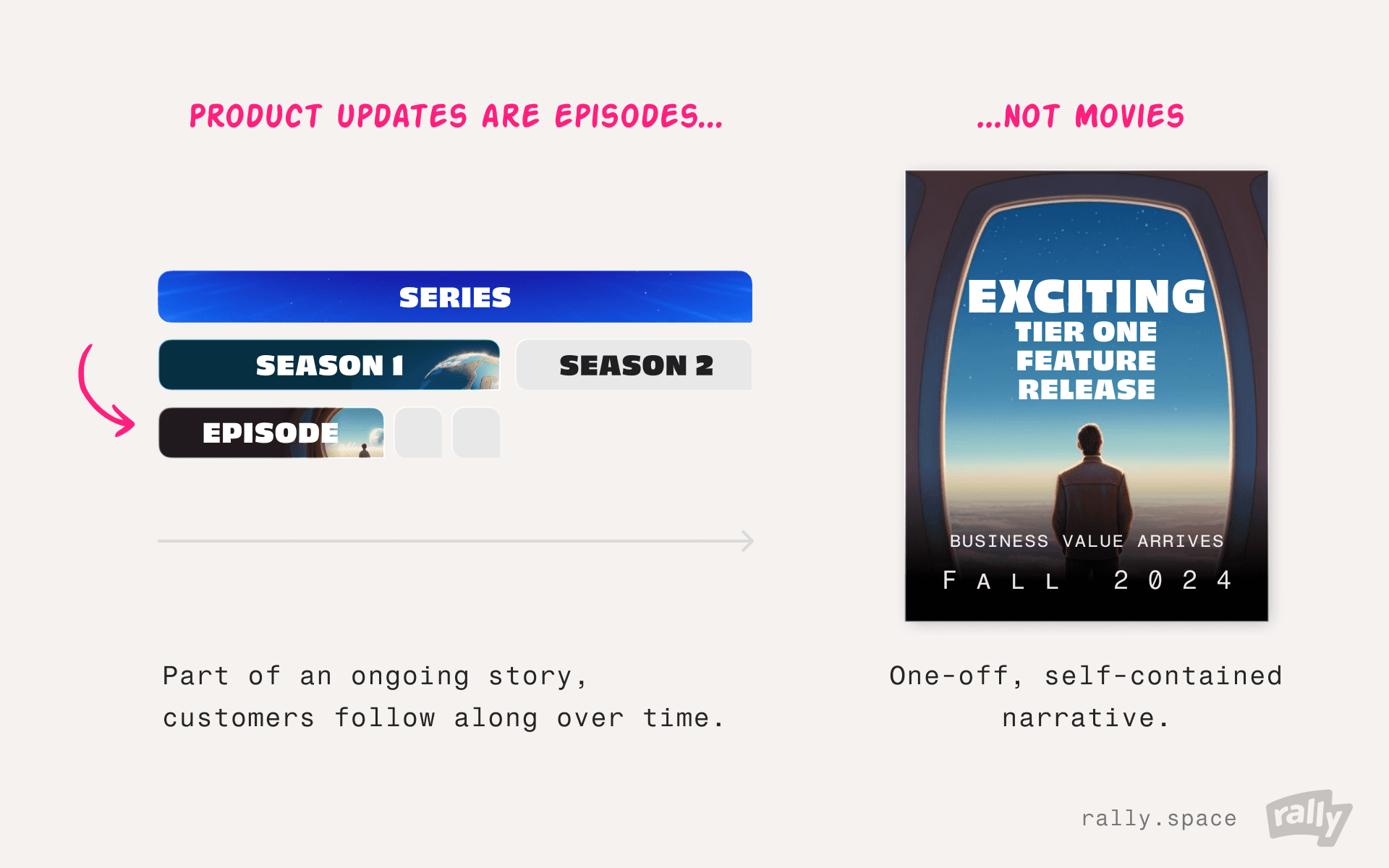
Going one step further, here's what a product's story might look like as a television series:
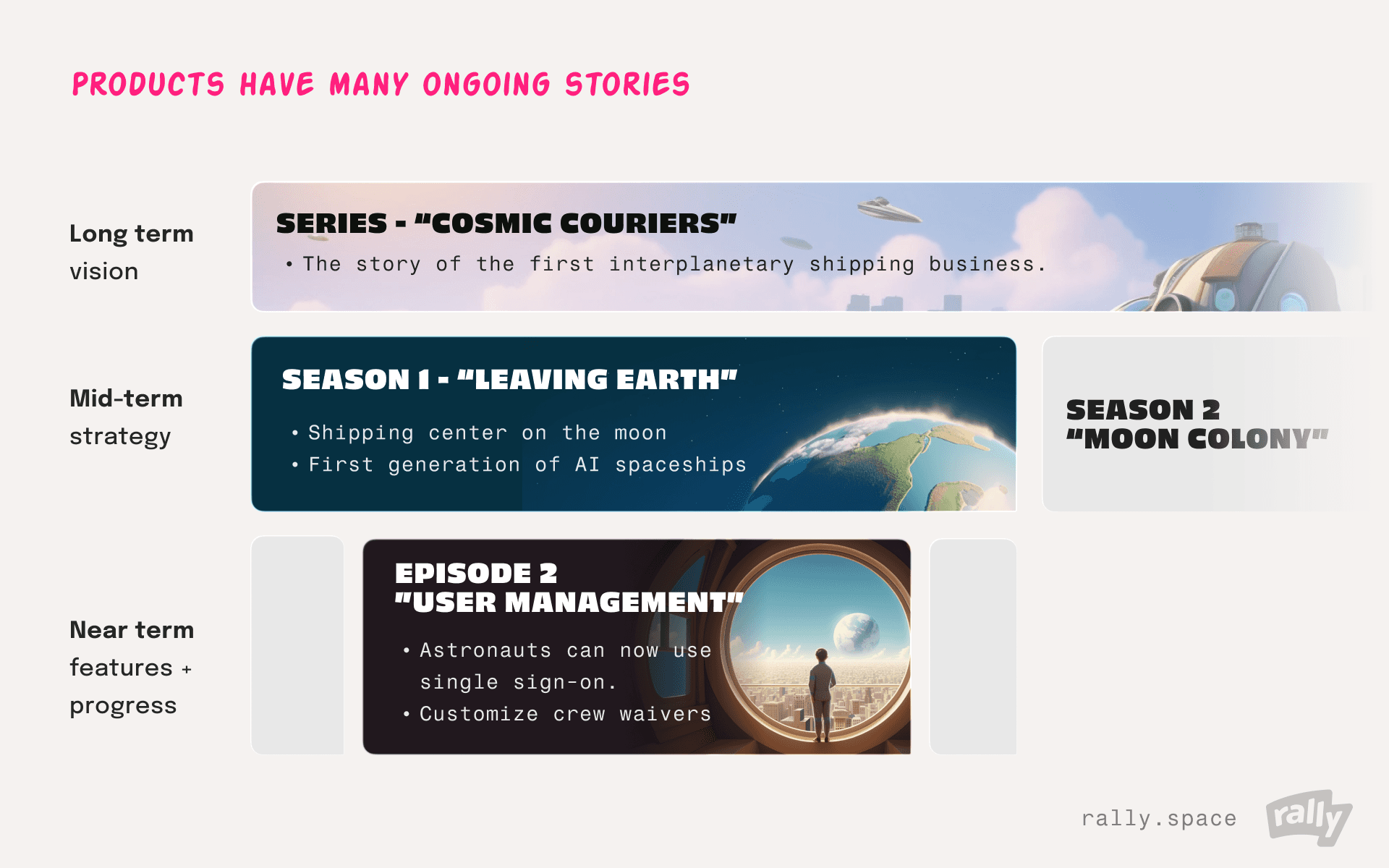
Product narratives are ongoing. This framing also aligns better to how customers think. An existing customer is plot-invested, so you can include more details (read: smaller updates) than with an audience who is brand new and still figuring out if they are interested.
Now that we’ve reframed the goal, how do we get started on our narrative?
Narratives in product storytelling
Narratives, Stories, and Storytelling
Great storytellers are skilled at using narratives to shape and share stories. To illustrate this, let’s say you shipped an analytics feature which allowed people to download a report including charts and data:
The story is the feature you shipped. You made analytics you can export, which is valuable because it lets you share data with others.
The narrative is how you tell the story and where it leads the audience. Narratives make choices for what to include, what to leave out, and where the journey takes you. The narrative changes for a data scientist vs. marketing executive audience — it’s the same story, told differently.
Storytelling is how you choose to apply the right narrative to make your story compelling to your audience.
Mapping features back to a larger narrative gives the story of your update greater purpose and a sense of progression. It moves product updates from “What are we working on?” to “What are we working towards?”
What is Narrative Design for product marketing?
Narrative Design is a way to develop higher quality stories, from overall company vision to roadmap features releasing this month. A narrative is how the story is told, vs what the story is — narrative design leads to frameworks which makes storytelling easier and more consistent.
Narrative design is a better way to discover stories you can tell about your product. Depending on your audience, you may tell different stories or tell the same story in a different way. Adjusting your narrative to fit your audience helps stories connect and stay memorable.
(In the game development industry, narrative is so important that you can get a full time job as a Narrative Designer.)
Narratives are a reusable foundation for storytelling
Narratives are ongoing, which makes them a useful framework for communicating change. They can start small, and connect up to larger narratives at the product, company, or market level. It’s OK to start small, and not every single update needs a connection to the grander story. As a tool for storytelling, narratives give us a framework for sharing how individual steps roll up to bigger things.
Aside: Part of the reason there are so many unsatisfying answers to questions like “What is a story?” is that it depends on who you ask — literary scholars have their version, which is just different enough from game developers, and also marketers. How deep does the rabbit hole go? You can find an entire field of Narratologists who literally study narrative structure. If we focus on finding the best technical definition, we’ll never get anything done — this version is good enough to get us started.
Designing product narratives
Each update can be a standalone story for customers, but it is also the latest episode in an ongoing story. Sometimes it is a short story, others span multiple episodes. There is progression, cliffhangers, and the occasional plot twists of a delayed launch date.
Ongoing product narratives is one way story-led organizations share their vision with their customers. We design customer narratives differently from other audiences because they are already familiar with the product.
Example: Finding a shared narrative
Let’s look at another example from “Cosmic Couriers”, a fictional space delivery company. This month they have two updates ready to go. What should their product marketing team do?
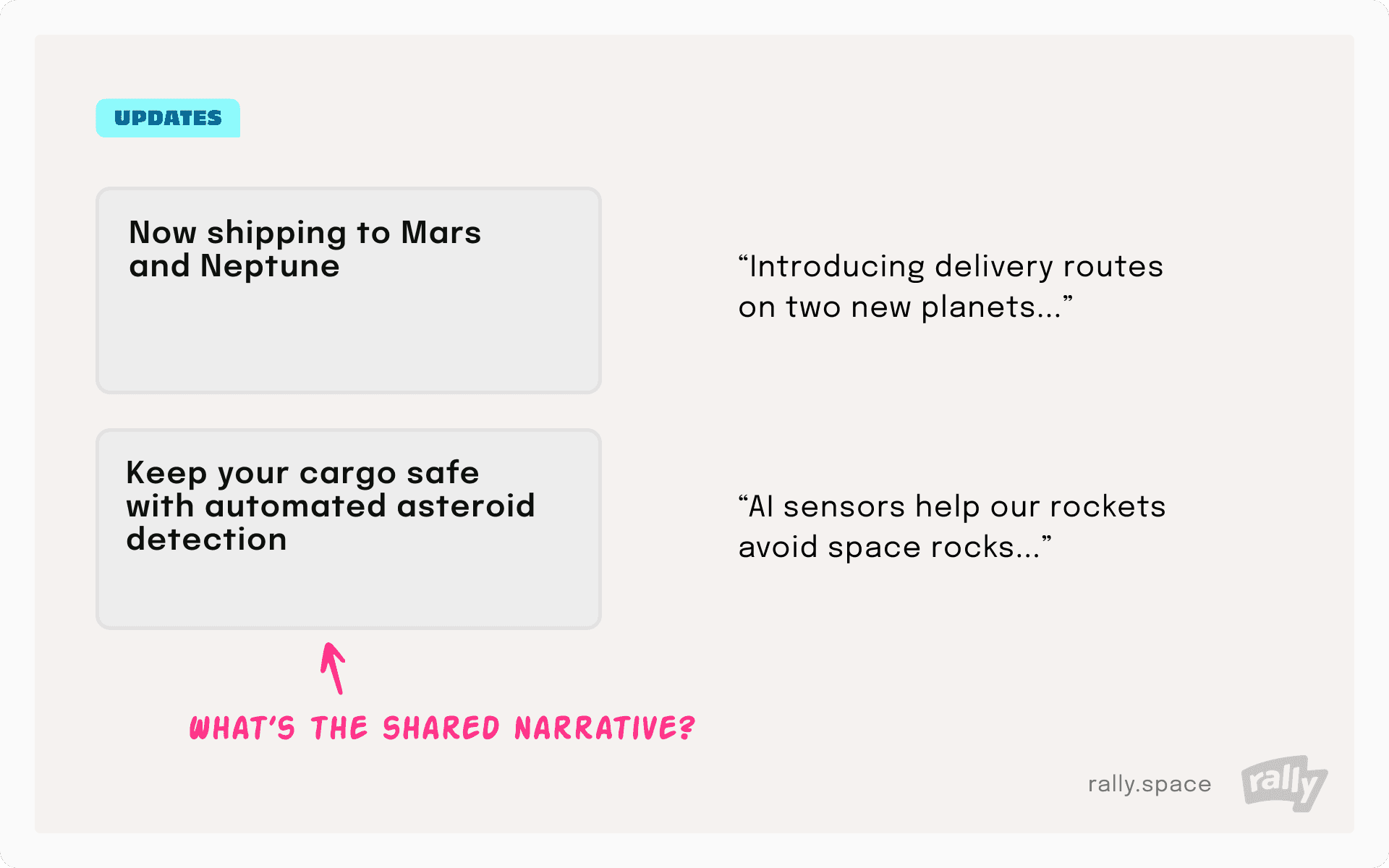
With these two updates, we might find a shared narrative around interplanetary shipping. With this context, each update is not just valuable — it’s yet another way we’ve made shipping between planets easier. You’re no longer just shipping features, you’re chasing a goal — nice!
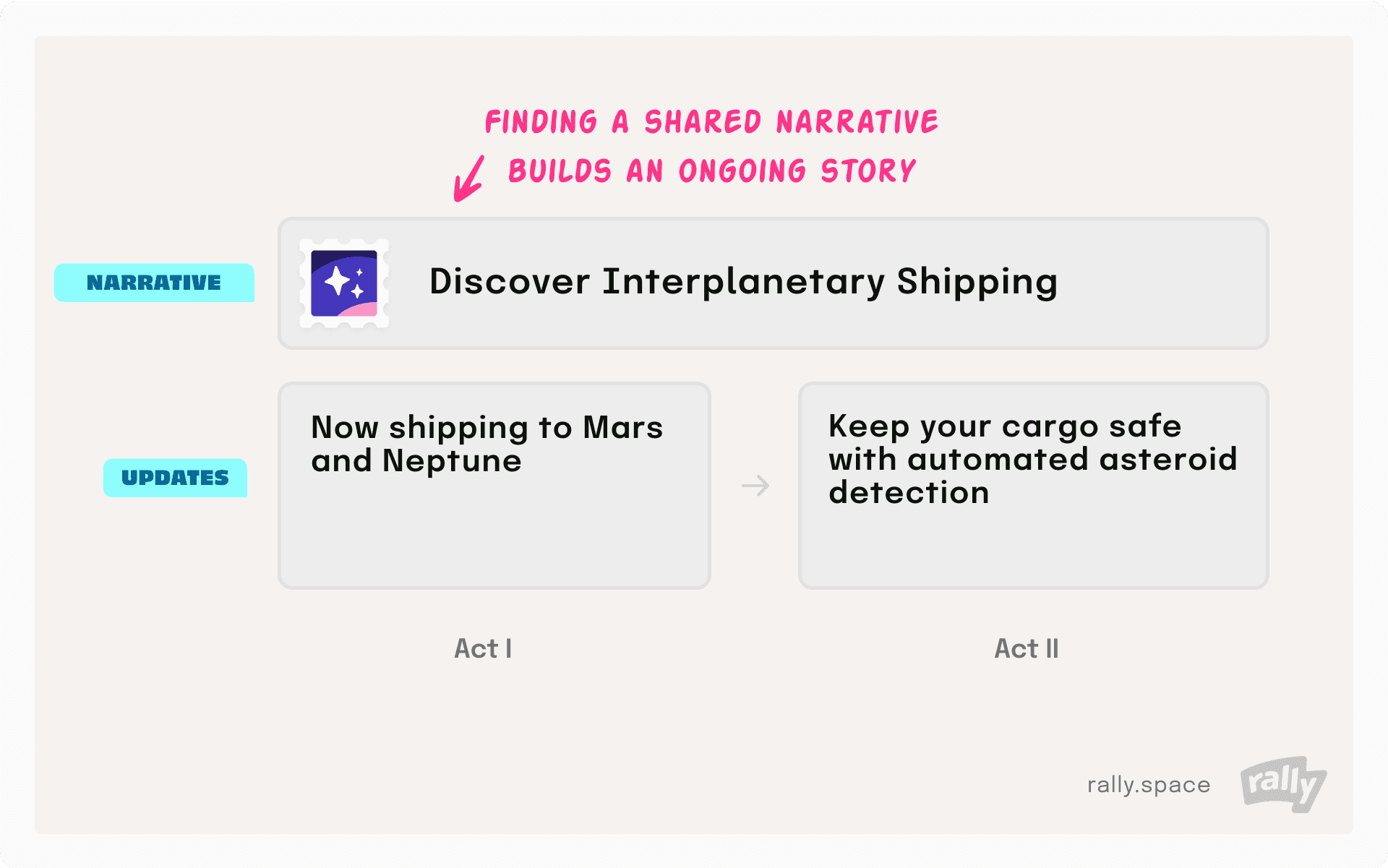
Ongoing narratives make storytelling simpler and give you more options. For example, because both updates are now part of the same story arc, we could flip the order and our framing would still make sense:
First: "This is one of the first changes we’re releasing this quarter to help you manage long distance shipping and reach new customers throughout the solar system…”
Second: “Last month we announced new delivery locations on Mars and Neptune, connecting you with thousands of potential future customers. Today we’re adding yet another way to make long distance shipping easier…”
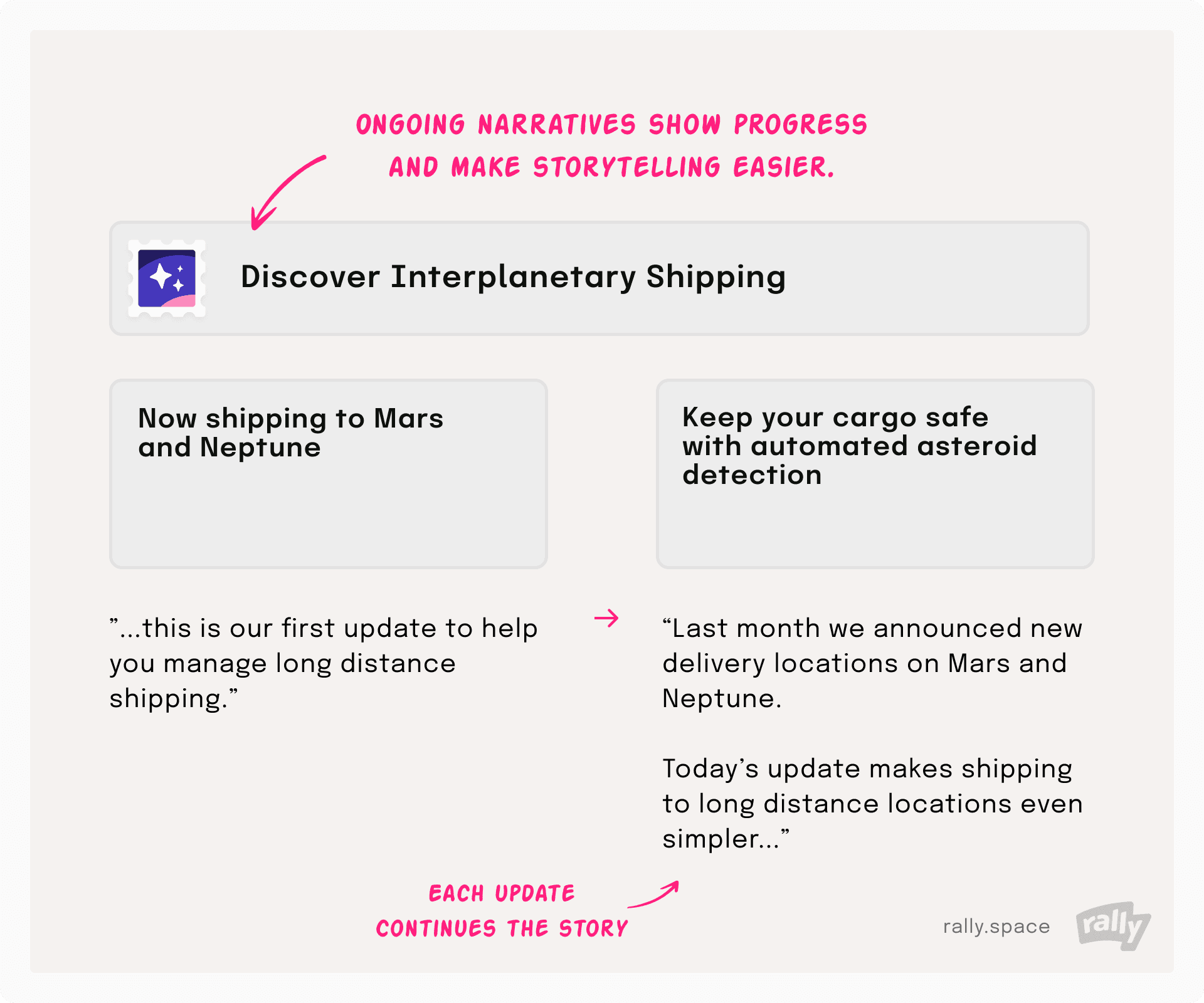
Advice for storytellers
A few tips before you get started:
Small features can also have narratives. You may not be able to use your normal process to get there and you will often need to discover possible narratives from a group of features with varying similarity. Sometimes the best path is to look at three releases, find the common thread (see: first principles thinking), and design a narrative which highlights that relationship. You can connect the dots further up the narrative chain if needed from there.
“Doesn’t this make updates more complicated?” No, updates should still be independently useful in the same way you can still watch a single episode of Law & Order without binging the entire series first. Including broader context from an ongoing story helps connect the specific change to the overall product narrative, helps customers understand the value faster.
In B2B, customers like when you are predictable because it helps them plan. Narrative themes help customers see the intention (and future) of your product, and how it fits into their long term strategy.
Not every release needs narrative development. Sometimes a bugfix or a quality of life improvement is exactly what it sounds like, and doesn’t need backing of a grandiose vision. Worse, trying to make every update sound groundbreaking is a surefire way to lose credibility, or at least get muted on LinkedIn.
Remember, your product is an ongoing story. Next time you have a batch of features to release, give narrative design a try — your customers will thank you.
Need to tell a better product story?
Learn how Rally makes great storytelling easy for your whole team, sales to customer.
